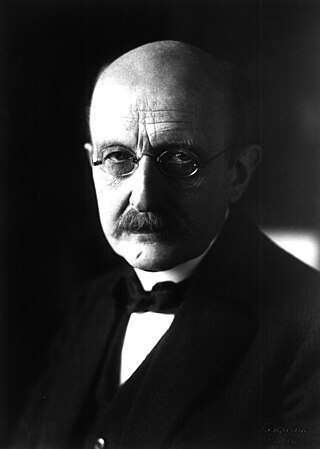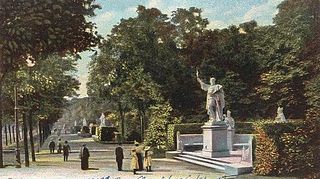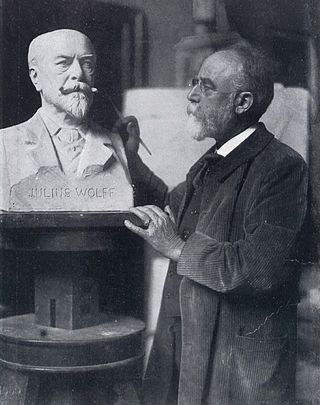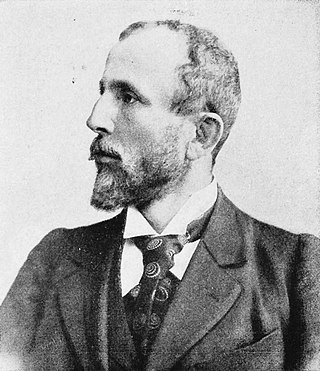
Max Karl Ernst Ludwig Planck was a German theoretical physicist whose discovery of energy quanta won him the Nobel Prize in Physics in 1918.

Max Reinhardt was an Austrian-born theatre and film director, intendant, and theatrical producer. With his innovative stage productions, he is regarded as one of the most prominent directors of German-language theatre in the early 20th century. In 1920, he established the Salzburg Festival with the performance of Hugo von Hofmannsthal's Jedermann.

Steglitz-Zehlendorf is the sixth borough of Berlin, formed in Berlin's 2001 administrative reform by merging the former boroughs of Steglitz and Zehlendorf.

Max Theodor Felix von Laue was a German physicist who received the Nobel Prize in Physics in 1914 for his discovery of the diffraction of X-rays by crystals.

The Kaiser Wilhelm Society for the Advancement of Science was a German scientific institution established in the German Empire in 1911. Its functions were taken over by the Max Planck Society. The Kaiser Wilhelm Society was an umbrella organisation for many institutes, testing stations, and research units created under its authority.

Noah Baumbach is an American film director and screenwriter. He is known for making witty and intellectual comedies set in New York City and has often been compared to writer-directors such as Woody Allen and Whit Stillman. His frequent collaborators include Greta Gerwig, Adam Driver, and Wes Anderson.

The Siegesallee was a broad boulevard in Berlin, Germany. In 1895, Kaiser Wilhelm II ordered and financed the expansion of an existing avenue, to be adorned with a variety of marble statues. Work was completed in 1901.

Klaus von Dohnanyi is a German politician of the Social Democratic Party (SPD). He served as mayor of Hamburg between 1981 and 1988.

The Berlin-Brandenburg capital region is one of the most prolific centers of higher education and research in the world. It is the largest concentration of universities and colleges in Germany. The city has four public research universities and 27 private, professional and technical colleges (Hochschulen), offering a wide range of disciplines. Access to the German university system is tuition free.

Benno Besson was a Swiss actor and director. He had great success as director at Volksbühne Berlin, Deutsches Theater and Berliner Ensemble in East Berlin, where he went by an invitation of Bertolt Brecht in 1949.

The Prussian Academy of Arts was a state arts academy first established in Berlin, Brandenburg, in 1694/1696 by prince-elector Frederick III, in personal union Duke Frederick I of Prussia, and later king in Prussia.

Nentershausen is a municipality in Hersfeld-Rotenburg district in northeastern Hesse, Germany.

Caan is an Ortsgemeinde – a community belonging to a Verbandsgemeinde – in the Westerwaldkreis in Rhineland-Palatinate, Germany.
Richard Eichberg was a German film director and producer. He directed 87 films between 1915 and 1949. He also produced 77 films between 1915 and 1950. He was born in Berlin, Germany and died in Munich, Germany.
The Leibniz Centre for Contemporary History Potsdam is an interdisciplinary research institute focusing on the contemporary history of Europe, especially Germany, and member of the Leibniz Association.

Das Volk was a daily newspaper published from Berlin, Germany. It was the central organ of the Social Democratic Party of Germany (SPD). The first issue of Das Volk was published on 7 July 1945. Das Volk was the second working class-newspaper to emerge in Berlin after the Second World War. During its first twenty days of publishing, Das Volk was printed in Berliner format. Das Volk heeded the calls of the Communist Party of Germany (KPD) for building an anti-fascist democratic Germany, a parliamentary-democratic republic and unity of the working class. The newspaper was controlled by the left-wing tendency inside SPD, and supported merger of the party with KPD.

Fritz (Friedrich) Schaper was a German sculptor.

Max Baumbach was a German sculptor.
Wolfgang Kaiser was a member of Rainer Hildebrandt's "Struggle against Inhumanty" group which campaigned against the one party dictatorship in the German Democratic Republic.

Die Humpty-Dumpty-Maschine der totalen Zukunft is a bronze sculpture created 2010 by Jonathan Meese, and installed at the Alte Nationalgalerie in Berlin, Germany, during 2011–2015.


















